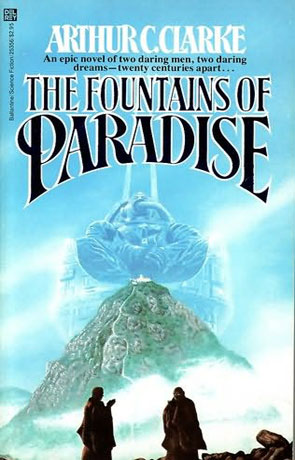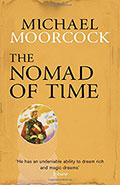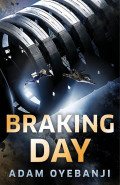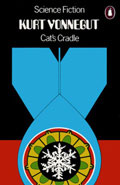The Fountains of Paradise
By Arthur C Clarke

- The Fountains of Paradise
-
Author: Arthur C Clarke
-
Publisher: Gollancz
- ISBN:
- Published:
- Pages: 356
- Format reviewed: Hardback
- Review date: 31/12/2012
- Language: English
The Fountains of Paradise was originally intended to be Arthur C Clarkes last novel and this is clearly reflected within both the backdrop - a fictional version of his home of Sri Lanka called Taprobane - and the narrative structure itself which feels very personal, much more so than any other of his book. It is often considered to be one of the authors finest works and won both the Hugo and Nebula awards for best novel.
Written in 1979 and set in the 22nd century, the story is all about that fantastic idea, the Space Elevator; a vast monument to space exploration that consists of a giant structure rising from the ground to link with a geostationary satellite in orbit over twenty two thousand miles above the earth.
It sounds like an idea that would be pure fantasy to build and yet it isn't outside the realms of possibility and even now clever scientists are thinking of how to create such a structure built around the idea of carbon nano-tubes and boron nitride nanotubes - the only things we know of that are theoretically strong enough to create cables that could survive the stresses inherent in such a structure.
The idea behind such a construction is that it would dramatically decrease the phenomenal energies needed to get things into space and was originally proposed in 1895 by Russian scientist Konstantin Tsiolkovsky who was inspired by the Eiffel Tower in Paris and thought of a tower reaching all the way to space.
It was this very novel, along with the almost simultaneously published book "The Web Between the Worlds" by physicist Charles Sheffield that popularised the theory, later followed by science fiction authors Robert Heinlein in 1982 with "Friday" and Kim Stanley Robinson in 1993 with "Red Mars".
The book itself is an incredible work of fiction which combines the authors capability to predict future technology along with his ability to describe such imaginative technology in a way that is easy to understand; wrapped around a story that is pleasing to read. The book has aged pretty well too, as with most books published before the 90's there is a distinct lack of smart mobiles (nobody seems to have guessed that technology) but otherwise there is little to really date the story. There are many grand ideas present too; Clarke's vision of the 22nd century is a world where countries live in relative peace and religion has pretty much petered out.
This is re-enforced by the emergence of an ancient alien ship slowly moving through the solar system and mocking the very concept of god, describing such a concept as anomalous; largely constrained to mammalian species and often abandoned when a sufficient level of scientific and social development is reached.
We also have the fictionalised life and death of the real, ancient Sri Lankan King Kashyapa I (described within the novel as King Kalidasa) which creates an effective juxtaposition to the main story. The sheer genius though is in the way this space elevator is envisaged, not just presenting us with the how it could be built but how it could be used too, acting as a stepping stone for man to get into space and begin to explore the larger universe.
I see The Fountains of Paradise as a precursor to reality, one day we will have a Space Elevator and when that day comes (hopefully within my lifetime) this book will be heralded as a large part in enabling such a dream.
A true classic piece of science fiction.
Written on 31st December 2012 by Ant .











